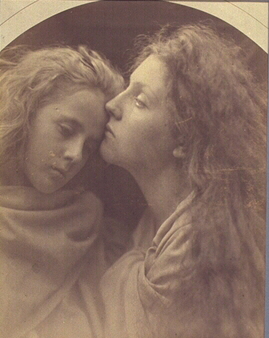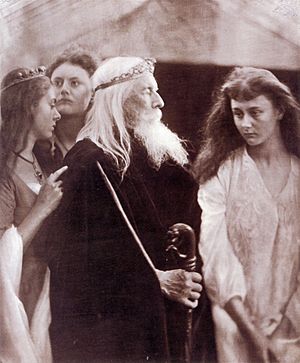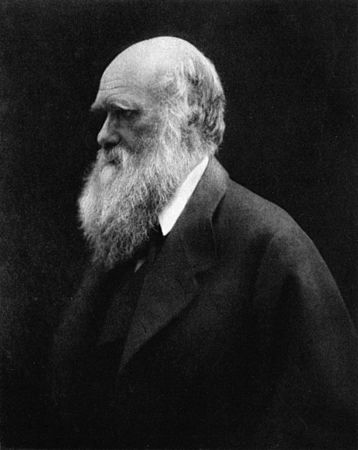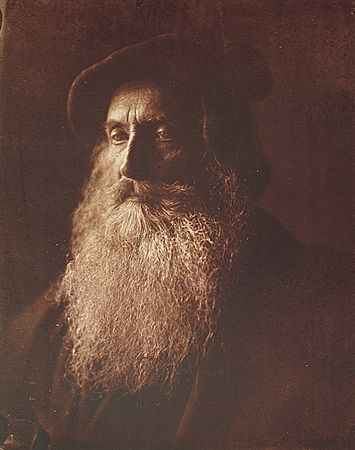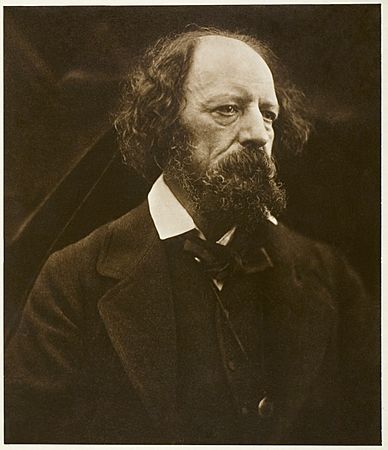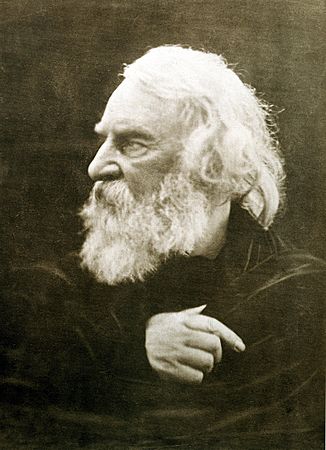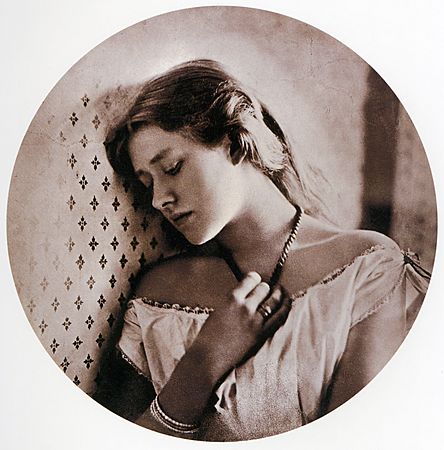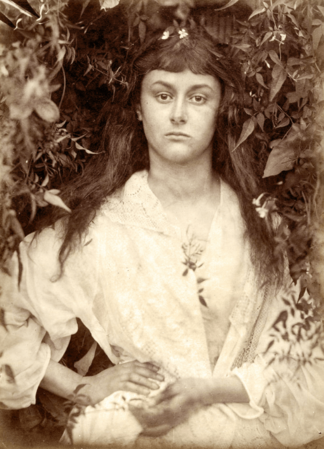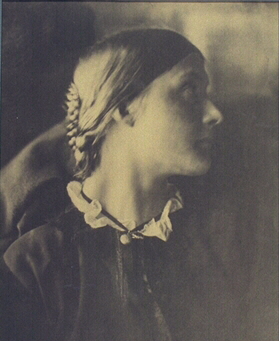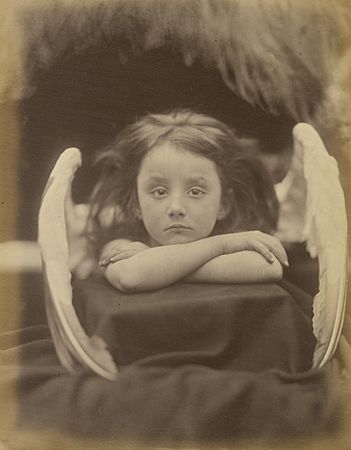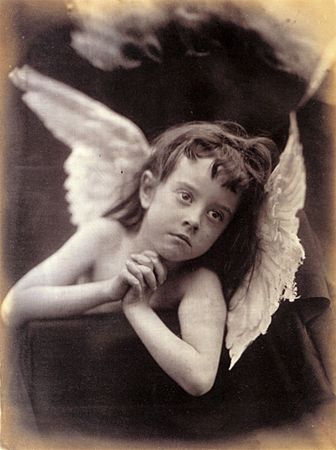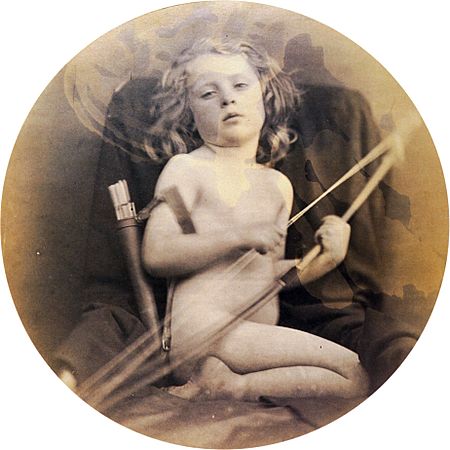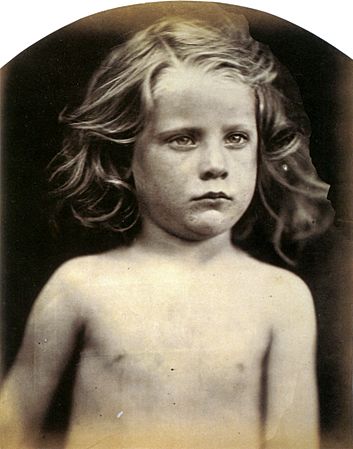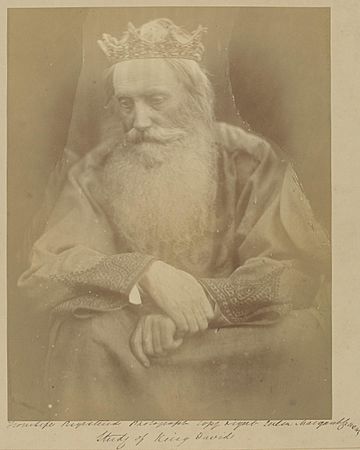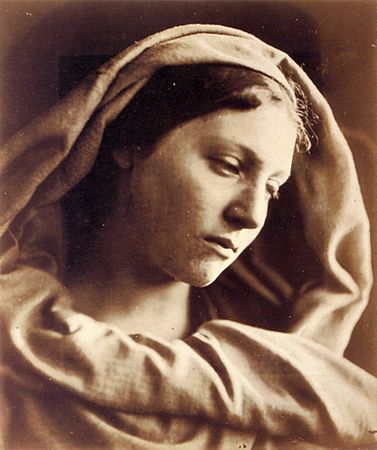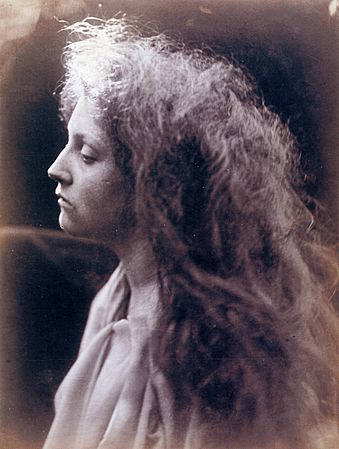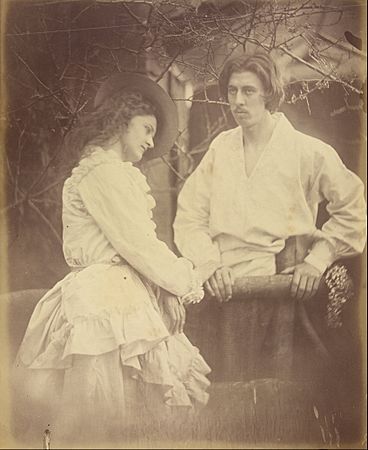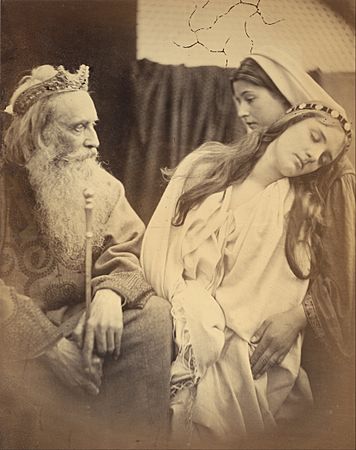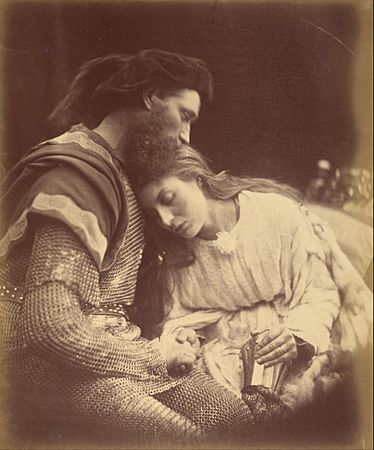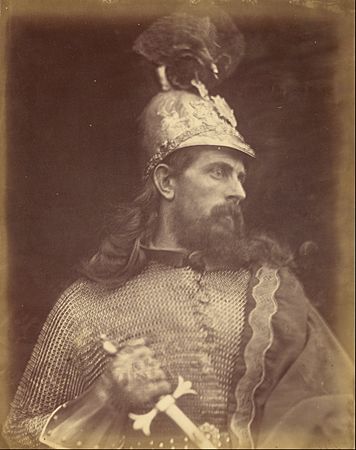Julia Margaret Cameron facts for kids
Quick facts for kids
Julia Margaret Cameron
|
|
|---|---|

Cameron in 1870
|
|
| Born |
Julia Margaret Pattle
11 June 1815 |
| Died | 26 January 1879 (aged 63) Kalutara, British Ceylon
|
| Nationality | British |
| Known for | Photography |
| Spouse(s) |
Charles Hay Cameron
(m. 1838) |
Julia Margaret Cameron (née Pattle; 11 June 1815 – 26 January 1879) was a British photographer who is considered one of the most important portraitists of the 19th century. She is known for her soft-focus close-ups of famous Victorian men and women, for illustrative images depicting characters from mythology, Christianity, and literature, and for sensitive portraits of men, women and children.
After establishing herself first among Calcutta's Anglo-Indian upper-class and then among London's cultural elite, Cameron formed her own salon frequented by distinguished Victorians at the seaside village of Freshwater, Isle of Wight.
After showing a keen interest in photography for many years, Cameron took up the practice at the relatively late age of 48, after her daughter gave her a camera as a present. She quickly produced a large body of work capturing the genius, beauty, and innocence of the men, women, and children who visited her studio at Freshwater, and created unique allegorical images inspired by tableaux vivants, theatre, 15th-century Italian painters, and the work of her creative contemporaries. Her photography career was short but productive; she made around 900 photographs over a 12-year period.
Cameron's work was contentious in her own time. Critics derided her softly focused and unrefined images, and considered her illustrative photographs amateurish and hammy. However, her portraits of respected men (such as Henry Taylor, Charles Darwin, and Sir John Herschel) have been consistently praised, both in her own life and in reviews of her work since. Her images have been described as "extraordinarily powerful" and "wholly original", and she has been credited with producing the first close-ups in the history of the medium.
Biography
Early life and education
Julia Margaret Cameron was born Julia Margaret Pattle on 11 June 1815, at Garden Reach, Calcutta, India, to Adeline Marie and James Peter Pattle.
James Pattle was a successful official from England who worked in India for the East India Company. His family had been involved with the East India Company for many years, though he traced his line to a 17th-century ancestor living in Chancery Lane, London. Her mother was a French aristocrat and the daughter of Chevalier Ambrose Pierre Antoine de l'Etang, who had been a page to Marie Antoinette and an officer in the Garde du Corps of King Louis XVI. When he died he was shipped back to London in a barrel of rum for burial in Camberwell.
Julia was the fourth of her parents' children. Three of her parents' children died in infancy. Julia and six of her sisters survived into adulthood, inheriting some Bengali blood through their maternal grandmother, Thérèse Josephe Blin de Grincourt. The seven sisters were known for their "charm, wit and beauty" and for being close, outspoken, and unconventional in behaviour and dress. They favoured Indian silks and shawls rather than the demure Victorian attire of other colonial woman.
All of the sisters were sent to France as children to be educated, Julia living there with her maternal grandmother in Versaille from 1818 to 1834, after which she returned to India.
Julia's sisters all made advantageous matches, Adeline marrying a military man who became a General, Sophia marrying a baronet, Louisa, a High Court Judge while Maria married the distinguished Dr John Jackson, with among their descendants being Vanessa Bell and Virginia Woolf. Sara married Henry Prinsep an administrator with the East India Company, and made their home at Little Holland House in Kensington, England an important intellectual centre. Among their children was Julia's godchild Julia Stephen. Virginia Pattle married Lord Charles Eastnor, later the third Earl Somers. Their eldest daughter was Lady Isabella Caroline Somers-Cocks, the temperance leader, while the younger, Lady Adeline Marie became the Duchess of Bedford.
Marriage and social life
South Africa and Calcutta
In 1835, after suffering several illnesses, Julia visited the Cape of Good Hope in South Africa with her parents to recover. It was common for Europeans living in India to visit South Africa to convalesce after an illness.
While there, she met the British astronomer and photochemist Sir John Herschel, who was observing the southern celestial hemisphere. She also met Charles Hay Cameron, twenty years her senior and a reformer of Indian law and education who later invested in coffee plantations in what is now Sri Lanka. Charles Hay was also there to convalesce, likely from a virulent malarial fever which often spread during the Indian monsoon season. The illness he suffered caused recurring kidney trouble and diarrhœa for the rest of his life.
They were married in Calcutta on 1 February 1838, two years after meeting. In December of that same year, Julia gave birth to their first child; Sir John Herschel was the godfather. Between 1839 and 1852, they had six children, one of whom was adopted. In all, the Camerons raised 11 children, five of her own, five orphaned children of relatives, and an Irish girl named Mary Ryan whom they found begging on Putney Heath and whom Cameron used as a model in her photographs. Their son, Henry Herschel Hay Cameron, would also become a photographer.
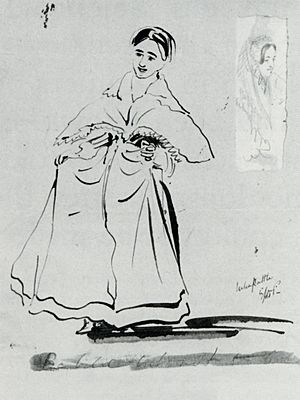
Through the early 1840s—as the organiser of social engagements for the Governor-General, Lord Hardinge—Cameron became a prominent hostess in Anglo-Indian society. During this time she also corresponded with Herschel about the latest developments in photographic technology. In 1839, Herschel informed Cameron about the invention of photography. In 1842, he sent her two dozen calotypes and daguerreotypes, the first photographs she ever saw.
England
Perhaps to be closer to their two children, the Camerons retired to England in 1845, where they took part in London's artistic and cultural scene. Julia often visited Little Holland House in Kensington, London, where her sister, Sara Prinsep, oversaw a literary and artistic salon "of Pre-Raphaelite painters, poets, and aristocrats with artistic pretensions". Here, she met many of the well-known subjects of her later portraits, including Henry Taylor and Alfred Tennyson.
Benjamin Jowett echoed this when describing Cameron's reverence to these creative personalities after a later visit to the same salon-like atmosphere at Freshwater, "She is a sort of hero-worshipper, and the hero is not Mr Tennyson – he only occupies second place – but Henry Taylor."
In 1847, she was writing poetry, had started a novel, and published a translation of Gottfried August Bürger's Leonora.
In 1848, Charles Cameron retired fully and invested in coffee and rubber plantations in Ceylon, becoming one of the island's largest landowners. The Camerons settled down in England, first in Tunbridge Wells in Kent, where they were neighbours of Taylor, then to East Sheen in 1850. During this time, Cameron became a member of a society for art education and appreciation and George Frederic Watts started working on a painting of Cameron (which is now in the National Portrait Gallery).
In 1860, after an extended visit to Alfred Tennyson at the seaside village of Freshwater, on the Isle of Wight, Cameron hastily purchased a property next door to Tennyson. The family moved there, naming the property "Dimbola" after one of the coffee plantations in Ceylon. A private gate connected the residences and the two families soon started entertaining well-known personalities with music, poetry readings, and amateur plays, creating an artistic scene much as what was previously found at Little Holland House. She lived there until 1875.
Photography career
Early career
Cameron showed an interest in photography in the late 1850s and there are indications that she experimented with making photographs in the early 1860s. Around 1863, her daughter and her son-in-law gave her her first camera (a sliding-box camera) as a Christmas present. The gift was meant to provide a diversion while her husband was in Ceylon tending to his coffee plantations. Of the gift, her daughter stated "It may amuse you, Mother, to try to photograph during your solitude at Freshwater."
After receiving the camera, she cleared out a chicken coop and converted it into studio space.
On 29 January 1864 she photographed nine‐year‐old Annie Philpot, an image she described as her "first success". That same year, she compiled albums of her images for Watts and Herschel, registered her work and prepared it for exhibition and sale, and was elected to the Photographic Society of London, of which she remained a member until her death and where she displayed work at yearly exhibitions.
Though Cameron took up photography as an amateur and considered herself an artist, and despite never making commissioned portraits nor establishing a commercial studio, she thought of her photographic activity as a professional endeavour, actively copyrighting, publishing, and marketing her work. Her family did not see substantial profits from their coffee plantations in Ceylon and Cameron may have been looking to bring in some money with her photography. The portraits of celebrities and the high volume of her photographic output also suggest commercial aspirations.
Mid-career
In 1865, she became a member of the Photographic Society of Scotland and arranged to have her prints sold through the London dealers P. & D. Colnaghi. She presented a series of photographs, The Fruits of the Spirit, to the British Museum, and held her first solo exhibition in November 1865. Her prints generated robust demand and she showed her work throughout Europe, securing awards in Berlin in 1865 and 1866, and an honourable mention in Dublin.
Her photographic activity was supported by her husband. Cameron wrote: "My husband from first to last has watched every picture with delight, and it is my daily habit to run to him with every glass upon which a fresh glory is newly stamped, and to listen to his enthusiastic applause."
In August 1865, the South Kensington Museum, now the Victoria and Albert Museum, purchased 80 of her photographs. Three years later, the museum offered her two rooms to use as a portrait studio, essentially making her the museum's first artist-in-residence.
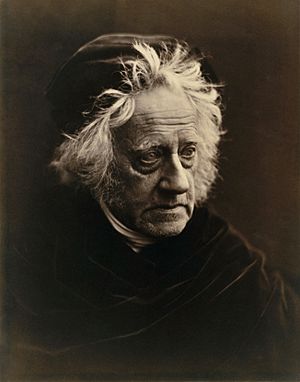
She produced images of Thomas Carlyle and John Herschel in 1867. By 1868, she was generating sales through P. & D. Colnaghi and a second London agent, William Spooner. In 1869, she created The Kiss of Peace, which she considered her finest work.
In the early 1870s, Cameron's work matured. Her elaborate illustrative tableauxs involving religious, literary, and classical figures peaked in a series of images for Tennyson's Idylls of the King, published in 1874 and 1875, evidently at her expense. During this time, she also wrote Annals of my Glass House, an unfinished memoir recounting her photographic career.
Later life
In October 1873, her daughter died in childbirth. Two years later, because of her husband's ill health, because of the lower cost of living, and to be nearer to their sons who were managing the family coffee plantations (which had been badly harmed by a fungus), Cameron and her husband left Freshwater for Ceylon with "a cow, Cameron's photographic equipment, and two coffins, in case such items should not be available in the East".
V.C. The move effectively marked the end of Cameron's photography career; she took few photographs afterwards, mostly of Tamil servants and workers. Fewer than 30 images survive from this period. Cameron's output may have dropped in part because of the difficulty working with collodion in the insect-friendly heat where fresh water was less available for washing prints. In February 1876, Macmillan's Magazine published her poem, On a Portrait. The following year, her image The Parting of Sir Lancelot and Queen Guinevere appeared on the cover Harper's Weekly as a wood engraving.
After a short visit to England six months earlier, Cameron fell ill with a dangerous chill and died on 26 January 1879 at the Glencairn estate in Ceylon. It is often reported that her last word was "Beauty" or "Beautiful".
In her 12-year career, Cameron produced around 900 photographs.
Photographic work
Influences
Cameron was an educated and cultured woman; she was a Christian thinker familiar with medieval art, the Renaissance, and the Pre-Raphaelites. She may also have been influenced by the contemporary interest in phrenology, the study of the human physiognomy as a sign of a person's character. The Old Masters also informed her work. Her compositions and use of light have been connected to Raphael, Rembrandt, and Titian.
John Herschel, who relayed to Cameron the news of the inventions of photography by Talbot and Daguerre, was an important influence on technique and the practicalities of the medium, as indicated in a letter Cameron wrote to the astronomer, "You were my first teacher and to you I owe all the first experience and insights."
It is likely that Cameron saw Reginald Southey photographing on the Isle of Wight during a holiday in 1857 when he visited the Camerons and photographed their children and the children of her neighbour, Alfred Tennyson, before Cameron took up the medium in earnest.
Perhaps the most important photographer to influence Cameron's work was David Wilkie Wynfield. Cameron's style of close-up portraits resembling Titian may well have been learned from Wynfield, since she took a lesson from him and later wrote "I consult him in correspondence whenever I am in difficulty". Much like Cameron, Wynfield published an album of soft-focus portraits of friends dressed up as characters from history or literature. The press compared their photographic work and noted the similarities in style and their consideration of the medium as fine art. She later wrote that "to my feeling about his beautiful photography I owed all my attempts and indeed consequently all my success".
Concept of genius and beauty
Cameron's portraits are partly the product of her intimacy and regard for the subject, but also intend to capture "particular qualities or essences—typically, genius in men and beauty in women". Mike Weaver, a scholar who wrote about Cameron's photography in work published in 1984, framed her idea of genius and beauty "within a specifically Christian framework, as indicative of the sublime and the sacred". Weaver supposes that Cameron's myriad influences informed her concept of beauty: "the Bible, classical mythology, Shakespeare's plays, and Tennyson's poems were fused into a single vision of ideal beauty."
Cameron herself indicated her desire to capture beauty. She wrote, "I longed to arrest all the beauty that came before me and at length the longing has been satisfied" and "My aspirations are to ennoble Photography and to secure for it the character and uses of High Art by combining the real & Ideal & sacrificing nothing of Truth by all possible devotion to poetry and beauty."
Her female subjects were typically chosen for their beauty, particularly the "long-necked, long-haired, immature beauty familiar in Pre-Raphaelite paintings".
Portraits
Cameron's photographs are generally placed into three categories: distinguished portraits of men, delicate portraits of women, and illustrative allegories based on religious and literary works.
Men
Cameron's portraits of men were a kind of hero-worship. To Thomas Carlyle, Cameron wrote "When I have had such men before my camera my whole soul has endeavoured to do its duty towards them in recording faithfully the greatness of the inner as well as the features of the outer man. The photograph thus taken has been almost the embodiment of a prayer."
Most of these men are well-known scientists, writers, or clergymen of the Victorian era. Cameron turned to Old Master paintings and the contemporary idea – based in phrenology – of the ideal "type" to capture the greatness that she perceived in these eminent Victorian individuals. Her aspiration to record this greatness resulted in powerful images displaying a masterly command of chiaroscuro that resulted in "the finest and most revealing gallery of eminent Victorians in existence".
Janet Malcom notes the attention Cameron paid to hair as an expressive element in her portraits, writing that "Her closeups of Tennyson, Carlyle, Darwin, Longfellow, Taylor, Watts, and Charles Cameron are as much celebrations of beards as of Victorian eminence."
-
Alfred, Lord Tennyson. Carbon print, 1869
Women
Her images of women are decidedly softer than those of men. With less dramatic lighting and a more typical distance between the sitter and the camera, these images are less dynamic and more conventional than her images of men.
Cameron almost exclusively photographed younger women, never making a portrait even of her neighbour and good friend Emily Tennyson. According to a biographer of Charles Darwin, Cameron refused to take a picture of Darwin's wife, saying that "no woman must be photographed between the ages of eighteen and seventy."
Her mature photographs of women are noted for their subtle but suggestive representation of the obscurity and malleability of female identity. Many of her images of young women obscure their individuality and represent their identity as multifaceted and changeable by showing them "in pairs, or reflected in a mirror... frequently expressive of a deep ambiguity and anxiety."
Janet Malcolm again notes Cameron's attention to the hair of her subjects, writing that "Like the little girls whose hair was mussed to rid it of its prim nursery look, the bigger girls were made to undo their buns and chignons so that their hair would poetically stream or flow or twist around their faces".
-
Ellen Terry 1864
-
Alice Liddell, 1872
Children
Children – her own children, those of relatives, and young locals – were often models for Cameron. Children were popular subjects in the Victorian era and Cameron kept with the prevailing notion of them as innocent, kind, and noble. She regularly depicted them as angels or as children from Bible stories.
The children in her images were not always cooperative, and her attempts to cast them as allegorical figures were often frustrated by the children's boredom, indignation, or distraction – moods which are often evidenced in her images.
Allegories and illustrations
Cameron may have found these illustrative group portraits more challenging than her other images. With more people in the image, the chances were greater that someone would move during the long exposures, so more light was needed to shorten the exposure time and arrest the motion. More sitters also meant a greater depth of field was necessary to put everyone in focus, further complicating the compositions.
Cameron's narrative portraits of women were influenced by tableaux vivants and amateur theatre. The women in her images are typically depicted in the idealised Victorian roles of mother and wife.
Religion
Cameron made over 50 images representing the Madonna, often played by her household servant Mary Hillier. These images present "an ideal of femininity that combines wholesomeness with qualities of sensuality and vulnerability". She represented the Virgin Mary in various scenes from the Bible, such as the Annunciation and the Salutation, but also created a number of images illustrating more obscure religious figures.
-
Sir Henry Taylor as King David 1866
Literature
Cameron took literature as inspiration for her illustrative photographs, representing characters from Shakespeare, Elizabethan poems, novels, plays, and the work of her contemporaries: Alfred Tennyson, Henry Taylor, Christina Rossetti, Robert Browning, and George Eliot.
Idylls of the King
In 1874, Alfred Tennyson asked Cameron to create illustrations for a new edition of his Idylls of the King, a popular series of poems about Arthurian legends. Cameron worked on this commission for three months, capturing several images in her notable soft focus style. She was unhappy with the final publication, and complained that the small size of her images depleted their significance. This prompted Cameron to issue a deluxe version of the Idylls of the King which featured a series of twelve photographs as full-size prints. This series of images, influenced in part by Watts, was her last large-scale project and is considered the peak of her illustrative work.
Retrospectives
In 2013, the Metropolitan Museum of Art curated an exhibition of Cameron's work, which garnered significant reviews.
In 2015 the Victoria and Albert Museum in London drew on their extensive collection of her work for a 200th anniversary retrospective of Cameron's career that also travelled to Sydney, Australia.
An exhibition at the National Portrait Gallery in London in March 2018 placed her work in relationship to the work of her Victorian contemporaries, Lady Clementina Hawarden, Oscar Rejlander, and Lewis Carroll.
The following retrospective exhibitions have focused on Cameron's oeuvre:
| Title | Dates | Institution | Country |
|---|---|---|---|
| Julia Margaret Cameron | 16 December 1960 – 31 January 1961 | Limelight Gallery | United States |
| Mrs. Cameron's photographs from the life | 22 January 1974 – 10 March 1974 | Stanford University Museum of Art | United States |
| Whisper of the Muse | 10 September 1986 – 16 November 1986 | Getty Villa | United States |
| Whisper of the Muse at Loyola Marymount University | 12 September 1986 – 25 October 1986 | Laband Gallery | United States |
| Portrait Photographs by Julia Margaret Cameron | 25 November 1987 – 14 February 1988 | National Portrait Gallery | United States |
| Julia Margaret Cameron: The Creative Process | 15 October 1996 – 5 January 1997 | Getty Villa | United States |
| 4 February 1998 – 3 May 1998 | Art Gallery of Ontario | Canada | |
| Julia Margaret Cameron: Nineteenth Century Photographic Genius | 6 February 2003 – 26 May 2003 | National Portrait Gallery, London | United Kingdom |
| 5 June 2003 – 30 August 2003 | National Media Museum | United Kingdom | |
| Julia Margaret Cameron, Photographer | 21 October 2003 – 11 January 2004 | Getty Center | United States |
| Julia Margaret Cameron | 19 August 2013 – 5 January 2014 | Metropolitan Museum of Art | United States |
| Julia Margaret Cameron | 15 August 2015 – 25 October 2015 | Art Gallery of New South Wales | Australia |
| Julia Margaret Cameron: Influence and Intimacy | 24 September 2015 – 28 March 2016 | Science Museum, London | United Kingdom |
| Julia Margaret Cameron | 28 November 2015 – 21 February 2016 | Victoria and Albert Museum | United Kingdom |
| Julia Margaret Cameron: A Woman who Breathed Life into Photographs | 2 July 2016 – 19 September 2016 | Mitsubishi Ichigokan Museum | Japan |
Albums
| Title | Dedication date |
|---|---|
| Mia Album | 7 July 1863 |
| Watts Album | 22 February 1864 |
| Herschel Album | 26 November 1864 |
| Overstone Album | 5 August 1865 |
| Lindsay Album | – |
| Thackeray Album | 1864 |
| Henry Taylor Album | – |
| Norman Album | 7 September 1869 |
| Aubrey Ashworth Taylor Album | 29 September 1869 |
List of selected publications
- Cameron, Julia Margaret (1973). Victorian photographs of famous men & fair women. Introductions by Virginia Woolf and Roger Fry. D. R. Godine. ISBN 978-0-87923-076-0. https://books.google.com/books?id=ZK4lAQAAIAAJ.
- Cameron, J. M. P. (1875). Illustrations by Julia Margaret Cameron of Alfred Tennyson's Idylls of the King and other poems
- Cameron, J. M. P. (1889). Unfinished autobiography "Annals of my glass house" by Julia Margaret Cameron, written 1874, first published 1889
- Cameron, J. M. (1975). The Herschel album: an album of photographs. London (2 St Martin's Place, WC2H 0HE): National Portrait Gallery
- Cameron, J. M., & Ford, C. (1975). The Cameron Collection: an album of photographs. Wokingham: Van Nostrand Reinhold for the National Portrait Gallery
- Cameron, J. M. P., & Weaver, M. (1986). Whisper of the muse: the Overstone album & other photographs. Malibu: J. Paul Getty Museum
See also
 In Spanish: Julia Margaret Cameron para niños
In Spanish: Julia Margaret Cameron para niños




